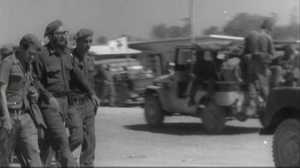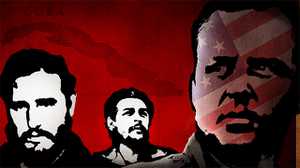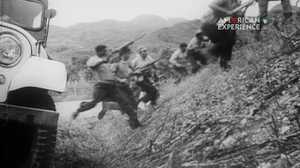Pre-Castro Cuba
On the eve of Fidel Castro's 1959 revolution, Cuba was neither the paradise that would later be conjured by the nostalgic imaginations of Cuba's many exiles, nor the hellhole painted by many supporters of the revolution. These revolutionaries recall Cuba as "the brothel of the Western hemisphere" -- an island inhabited by a people degraded and hungry, whose main occupation was to cater to American tourists at Havana's luxurious hotels, beaches and casinos. Rather, Cuba was one of the most advanced and successful countries in Latin America.

Success by the Numbers
Cuba's capital, Havana, was a glittering and dynamic city. In the early part of the century the country's economy, fueled by the sale of sugar to the United States, had grown dramatically. Cuba ranked fifth in the hemisphere in per capita income, third in life expectancy, second in per capita ownership of automobiles and telephones, first in the number of television sets per inhabitant. The literacy rate, 76%, was the fourth highest in Latin America. Cuba ranked 11th in the world in the number of doctors per capita. Many private clinics and hospitals provided services for the poor. Cuba's income distribution compared favorably with that of other Latin American societies. A thriving middle class held the promise of prosperity and social mobility.

Inequalities
There were, however, profound inequalities in Cuban society -- between city and countryside and between whites and blacks. In the countryside, some Cubans lived in abysmal poverty. Sugar production was seasonal, and the macheteros -- sugarcane cutters who only worked four months out of the year -- were an army of unemployed, perpetually in debt and living on the margins of survival. Many poor peasants were seriously malnourished and hungry. Neither health care nor education reached those rural Cubans at the bottom of society. Illiteracy was widespread, and those lucky enough to attend school seldom made it past the first or second grades. Clusters of graveyards dotted the main highway along the foothills of the Sierra Maestra, marking the spots where people died waiting for transportation to the nearest hospitals and clinics in Santiago de Cuba.
Two Worlds
Racism also blighted Cuban society. The island's private clubs and beaches were segregated. Even President Fulgencio Batista, a mulatto, was denied membership in one of Havana's most exclusive clubs. "One might best summarize the complex situation by saying that urban Cuba had come to resemble a Southern European country (with a living standard as high or surpassing that of France, Spain, Portugal and Greece) while rural Cuba replicated the conditions of other plantation societies in Latin America and the Caribbean," according to analyst Mark Falcoff.

Chaotic Political Scene
Cuba's social problems were compounded by a violent, chaotic and corrupt political history. Since achieving independence in 1902, Cuba had suffered what simply could be called bad government. A bloody and costly struggle to achieve independence from Spain had devastated Cuba's economy. The insurgent leaders, known as the mambises, had been decimated. José Martí, Cuba's George Washington, was killed in battle in 1895. On May 20, 1902, the birth date of the first Cuban republic, no leader had the power to harness the passions and ambitions unleashed by independence. The U.S. Congress passed the Platt Amendment, granting the U.S. the right to intervene militarily in Cuba to protect its interests there. The U.S. position further undermined the legitimacy of the government, as it placed the United States at the center of Cuban affairs. Invoking the Platt Amendment, the United States would occupy Cuba between 1906 and 1909, and continue to intervene in later years.
Democratic Hopes
All the tensions of the First Republic exploded in revolution in 1933. University students, labor unions, and disaffected army officers joined in rebellion against Cuba's fifth president, Gerardo Machado, a man who had taken corruption and repression to new heights. A university professor, Ramón Grau San Martín, took power at the head of a coalition. A nationalist, Grau called on "Cuba for all Cubans," but the U.S. ambassador, Sumner Welles, made a deal with Fulgencio Batista, an English-speaking army sergeant, who unseated Grau. Batista became Cuba's strongman behind a succession of presidents until 1940, when he was duly elected president. Batista surprised many, ushering in an era of hope in Cuba by sponsoring a progressive constitution, allowing the Cuban Communist Party to join the government, and stepping down in favor of his opponent, Grau, when his four-year term was over.
Plagued by Corruption
For the next twelve years Cuba enjoyed democracy and free elections. But it was a democracy marred by corruption and political violence -- the work of "action groups" or gangs who shot their way through politics at the University of Havana and on the city streets. When in March 1952, Batista, in a coup d'etat, destroyed the democratic republic he had brought into existence, the stage was set for revolution. "Batista's coup opened a Pandora's box," explained writer Carlos Alberto Montaner. "Institutions no longer mattered. What mattered was audacity, the individual capable of violent action." That individual turned out to be a daring young lawyer named Fidel Castro.
Era of Change
Between 1952 and 1958, Cubans from all walks of life -- students, businessmen, mothers, politicians -- united in opposition against Batista. Author Carlos Alberto Montaner describes the mood: "the talk was about democracy, freedom and respect for human rights; the... objective was to restore the rule of law that had been swept aside by Batista."

Hopes for Honest Government
Even Castro -- a dynamic national figure following his failed Moncada assault of 1953 -- spoke in those terms. "Not Communism or Marxism is our idea. Our political philosophy is representative democracy and social justice in a well-planned economy." Many wealthy Cubans welcomed Castro's rebel triumph in January 1959. "My parents, my grandparents and my uncles went out and paid their back taxes," recalls Professor Marifeli Pérez Stable, "because finally, there was going to be an honest government in Cuba."
*This article was originally published on the site for the 2005 American Experience documentary Fidel Castro.









